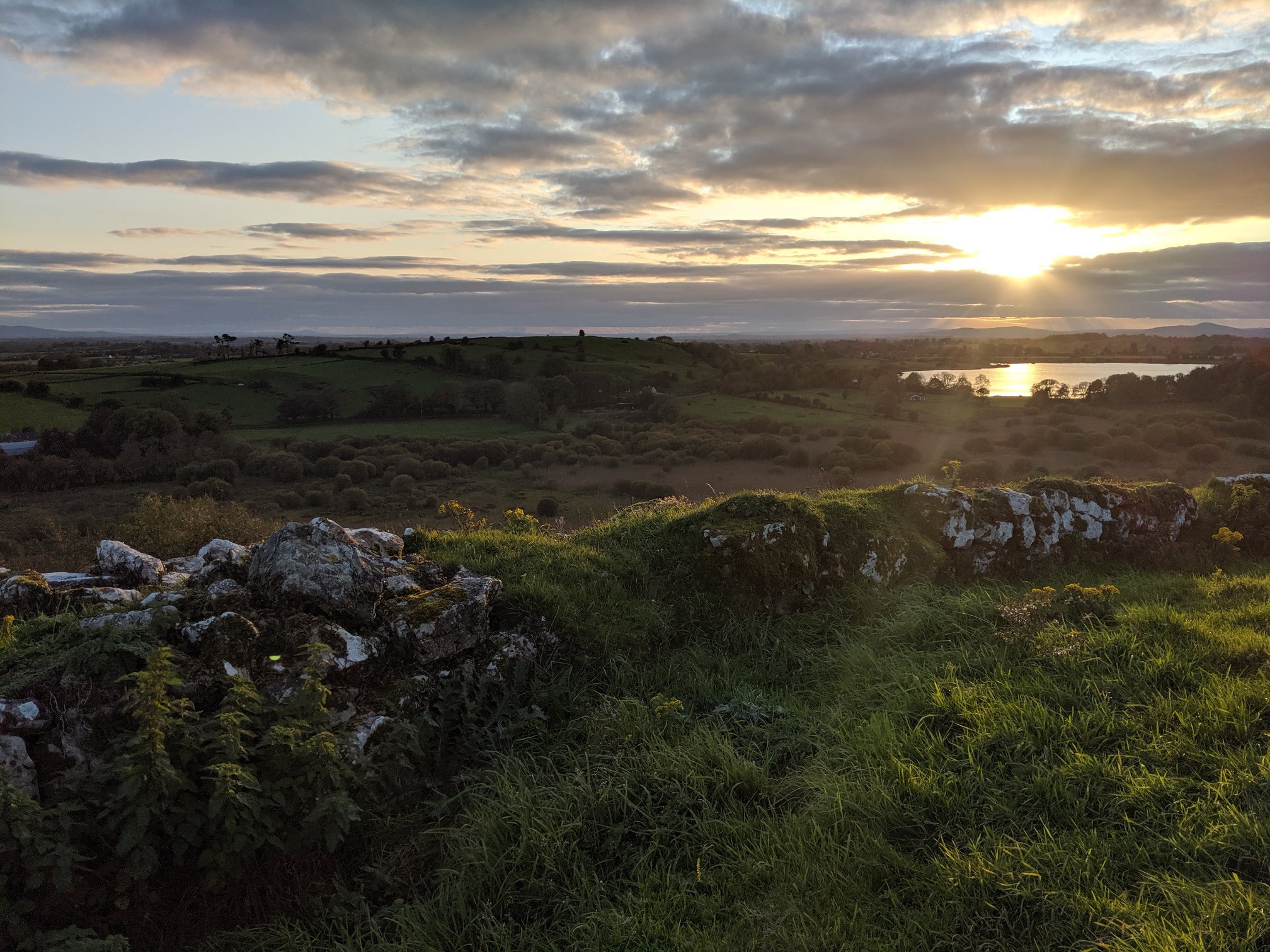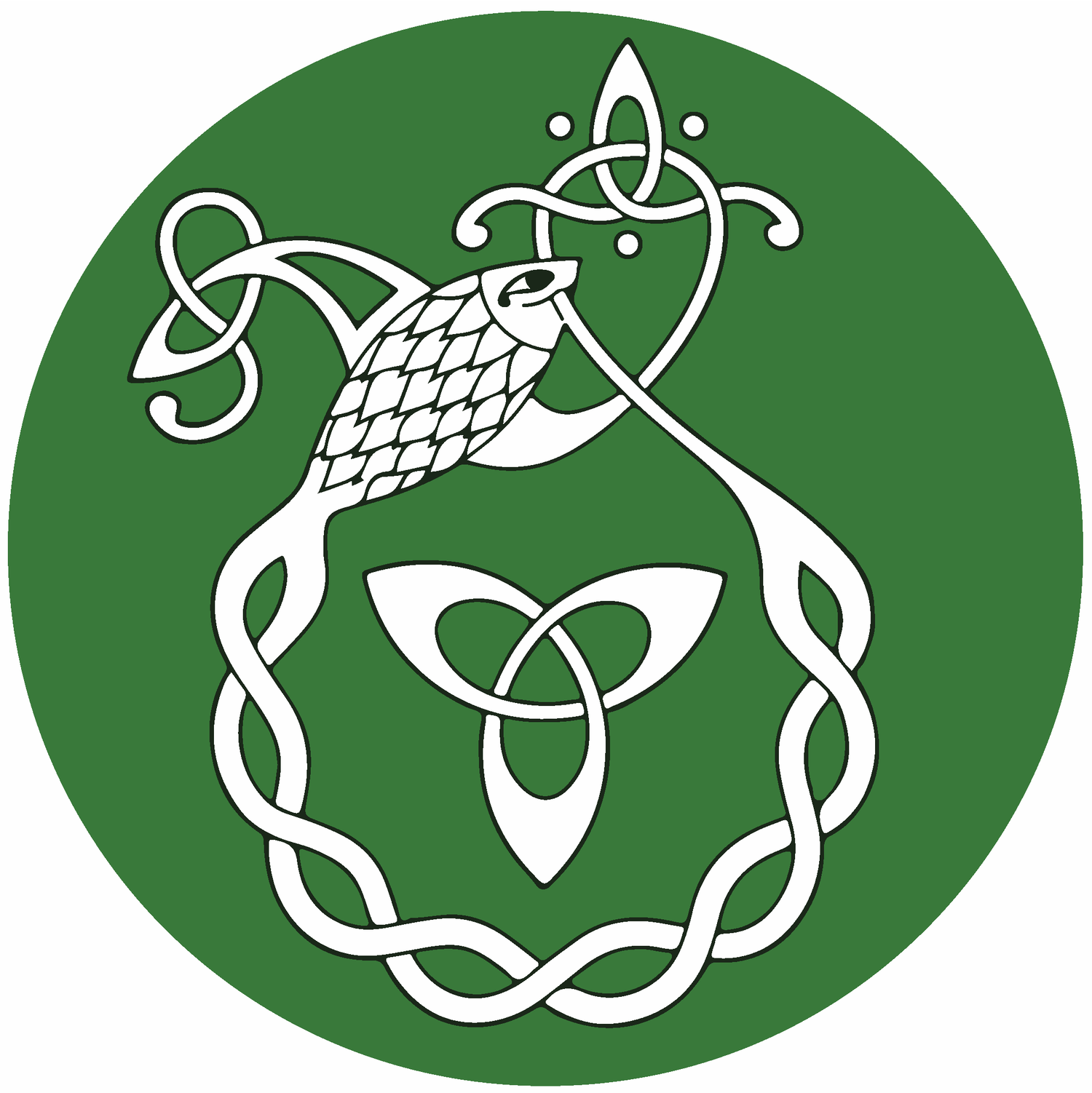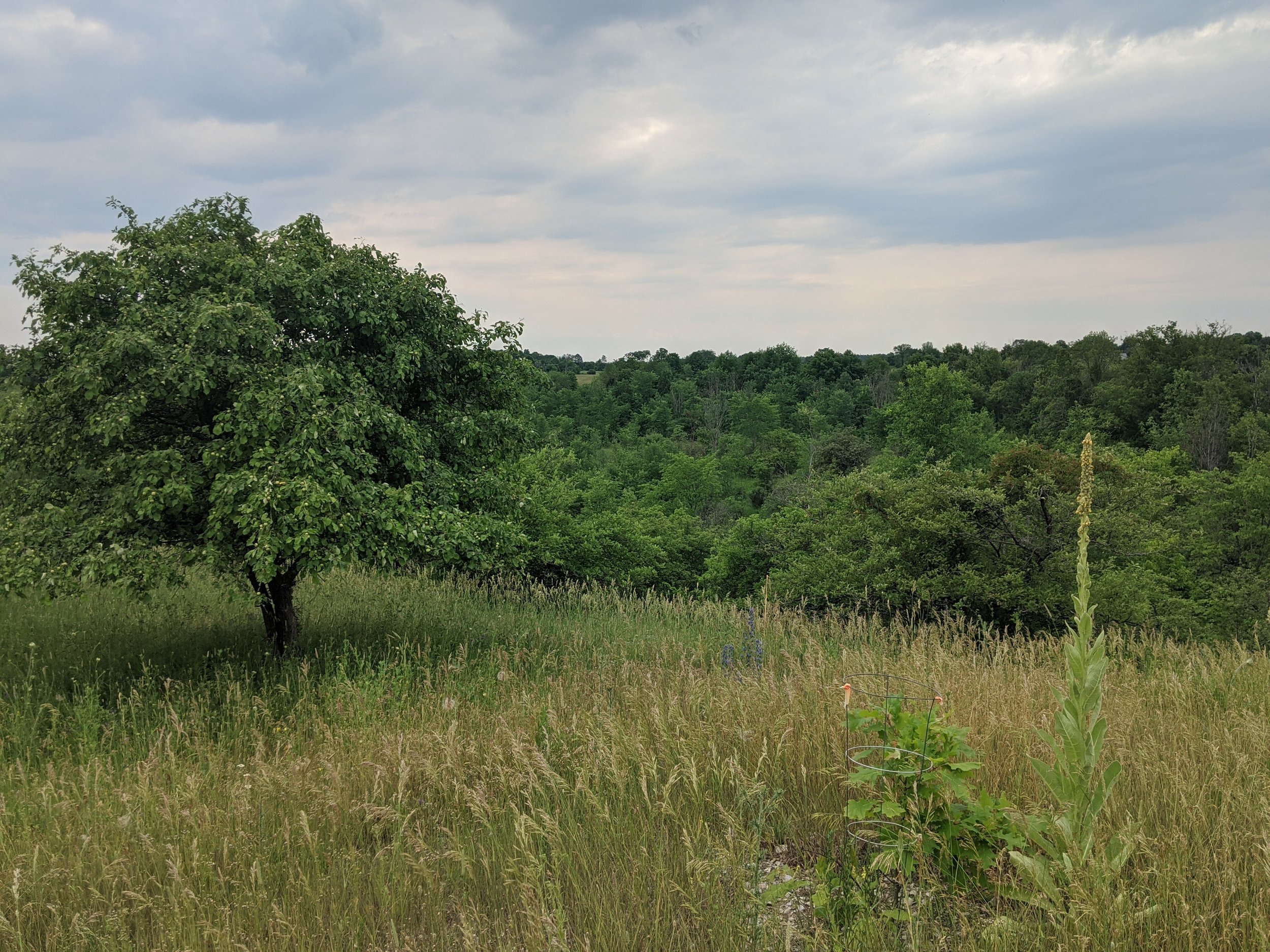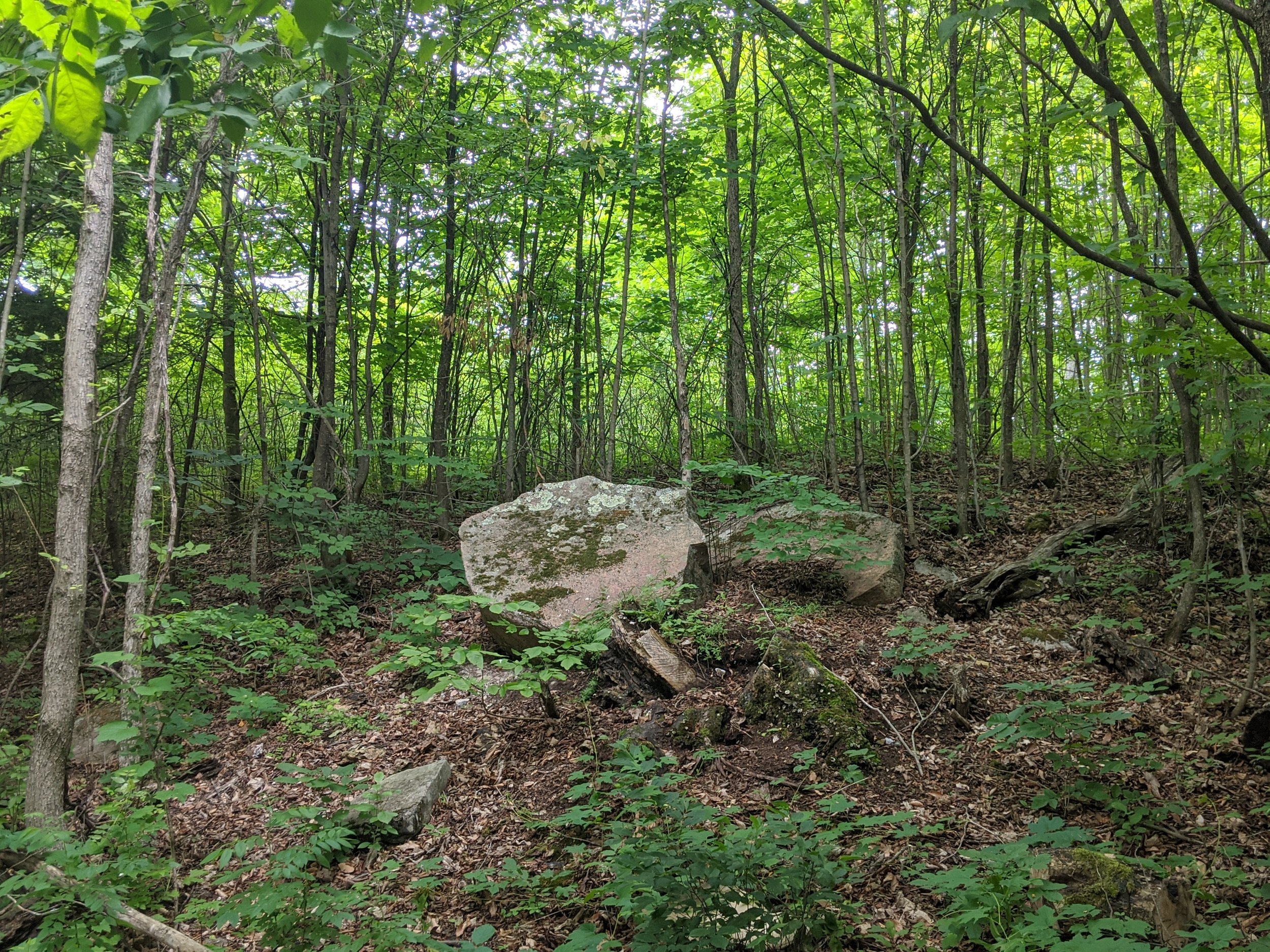
The World Around Us
Timpeall Orainn
Saol trí mhíol mhór saol iomaire amháin
Saol trí iomaire saol an domhain.
The lifespan of three whales is the lifespan of a single cultivation ridge
The lifespan of three ridges is the lifespan of the world
“A whale was thought to live for one thousand years … the cultivation ridges that we see in the fields around us [eg. Céide Fields] could be up to three thousand years old … The span of three cultivations ridges would amount to nine thousand years, which takes us back to the time when archaeologists believe significant numbers of humans first settled [in Ireland] - the beginnings of our world. That our people appear to have kept a count of how long we have been here - and that they encoded it in our language - is precious.”
Magan, Manchán. 2020. Thirty-Two Words for Field. MH Gill: Dublin.

Festivals and Seasons
Roth Mór an tSaoil
In Gaelic culture, we have a special name for the passing of time and the flow of life—it's called "roth mór an tsaoil," or the great wheel of life. It represents how life and time keep repeating in a pattern. Before we had time zones and international calls, people relied on the sun's position in the sky to know the time of day. Unlike English, our base unit of time was actually two-weeks, called a “coicís” in Irish, which is the time between two new moons. Instead of using calendar dates, we based time on holidays and festivals, like saying “Seacht seachtaine ramhra ó Shamhain go Nollaig” meaning “There are seven fat weeks between Halloween and Christmas.” By looking at the sky and knowing the cycle of time, we could tell exactly when it was without needing watches or calendars.
Our ancestors could also predict when the seasons would come and go and what would happen next by carefully watching nature's cycles. For example, ants were considered very wise creatures, and if the ants are moving slowly, it tells us that stormy weather is coming.
People's lives also follow a wheel or cycle. Each stage of life has its own importance. Childhood is a time for learning and growing, adulthood is for working and starting a family, and old age is when people gain wisdom and reflect on their experiences. To describe the different stages of life In Irish, we say things like “Fiche bliain ag fás, fiche bliain faoi bhláth, fiche bliain ag meath, is fiche bliain gur cuma ann nó as” meaning “twenty years growing, twenty years flowering, twenty years declining, and twenty years where it doesn’t matter if you are here or not.” Sometimes, older men are still referred to as boys if they haven't married and started a family.
By understanding these cycles, we can navigate our own life's journey and make the most of each stage. We know that everything has happened before and will happen again. It reminds us that we are part of something bigger than ourselves.

An Geimhreadh - Winter
In Ireland, winter was traditionally said to be from Samhain (November 1st) until St. Brigid's day (February 1st). During the long nights and cool evenings, it was a cherished tradition for generations to gather around the fireplace and share captivating tales of giants, gods, heroes, and local stories passed down through the ages.
December 26 – Lá ‘le Stiofáin
St. Stephen's Day also known as Wren Day, is an ancient tradition where groups of people, known as Dreoilíní or Wren Boys, dress up in colorful costumes made from cloth and straw (some say in the guise of the Good People) and go from house to house, singing, dancing, and playing music. The day is also associated with acts of charity, and donations are collected for charitable causes.
January 1 - Lá Caille
New Year's Eve is a time when people refrain from giving anything away for fear of setting the precedent for the rest of the year. It is believed that giving away items like milk, money, burying people, or even throwing out the floor sweepings on this day may result in accidentally giving away all of those things for the rest of the year.
January 6 - Nollaig na mBan
Women's Christmas, or Little Christmas, is a day when men traditionally take over the household chores, allowing women to relax and enjoy themselves. It is a day for women to socialize and often involves gathering in pubs.

An tEarrach - Spring
In Ireland, spring was traditionally said to be from Imbolg (St. Brigid's Day, Feb. 1st) until Bealtine (May 1st). It marks a season of new beginnings and growth as the winter frost recedes. Farmers prepared the fields for planting crops and baby animals would be born (“Imbolc” is the old term for the feast day and means “in the belly”). The arrival of spring symbolizes the transition from the dark half of the year to the light half, as longer days and warmer weather begin.
February 1 - Lá 'le Bríde
St. Brigid’s Day, also known as Imbolg, marks the arrival of spring and is dedicated to Saint Brigid, one of Ireland's patron saints. On this day, people make St. Brigid's crosses out of rushes, which are believed to bring protection and blessings, with a new one made each year (and the old one kept in the rafters). It is seen as a turning point when the days become longer and brighter. Imbolg comes from “i mbolg” because the lambs are “in the belly” of the sheep.
March 17 - Lá 'le Pádraig
St. Patrick's Day is celebrated on March 17th. It commemorates Saint Patrick, the patron saint of Ireland, and is a significant festival worldwide, though is celebrated quite a bit differently in Ireland than in America. People participate in parades, wear green attire, and engage in festivities that showcase Irish culture, music, and dance. It is also a time when crops are traditionally planted. It is traditionally a respectful religious festival, with older men gathering at the pub in the evening for a few drinks together.

An Samhradh - Summer
summer starts on May 1st and continues until Lúnasa, which is the nearest Sunday to August 1st. During this time, people in Ireland traditionally pay special attention to their animals that spend the summer outdoors. They make sure to protect them from harm and provide them with everything they need to stay healthy. Summer is a season of warmth and growth, when the days are longer and the weather is usually pleasant. It's a time for outdoor activities, enjoying nature, and celebrating the beauty of the Irish countryside.
May 1 - Bealtine
Also known as the start of summer, Bealtine is one of the most important festivals in ancient Irish culture. It is often referred to as Ceann Féile, meaning the chief festival, and is associated with increased supernatural activity. Many customs during Bealtine revolve around protecting livestock and ensuring a successful farming season. One of these traditions includes driving cattle between two fires to purify them, close enough that their hair is slightly singed. This is the reason we call it Bealtine, anciently meaning “the bright fire.”
June 24 – Lá ‘le Eoin
The Feast of St. John the Baptist, or Midsummer's Day, falls on June 24th. It celebrates the summer solstice. Lighting bonfires is a common tradition on this day, and people come together to enjoy music, dancing, and feasting. It is a time for community gatherings and merriment. Saint John the Baptist is also the patron saint of Quebec and his feast day is associated with the arrival of French explorers in Quebec in the 17th century. Saint-Jean-Baptiste Day is celebrated as La Fête nationale du Québec. St. John’s (Newfoundland), Saint John (New Brunswick) and PEI (previously called “St. John’s Island) were also all named after this saint.

An Fómhar - Autumn
Autumn in Ireland is traditionally said to last from Lúnasa (nearest Sunday to August 1st) until November 1st. This is the time of the harvest, celebrations of the dead, and the beginning of the ‘dark’ half of the year.
August 1 - Lúnasa
Also known as “Domhnach Chrom Dubh” meaning the Sunday of the god Crom Dubh,” Lúnasa is a harvest festival that takes place on the last Sunday of July or the first Sunday of August, whichever is closer to August 1st. It celebrates the ancient festival of the god Lugh, and the first fruits of the harvest season. Many people embark on pilgrimages to Cruach Phádraig, a mountain in County Mayo, as part of the tradition. Lúnasa is mentioned in some of the earliest Irish literature and involved religious ceremonies, matchmaking, and the ancient Irish Olympics, the Tailteann Games.
October 31 - Samhain
Oíche Shamhna is a festival associated with the feast of the dead and the presence of spirits and supernatural beings. It is celebrated on October 31st and marks the end of the harvest season and the beginning of winter. Samhain is the source of North American Halloween traditions, starting as an emigrant cultural festival (with the first references in North America to Halloween being celebrated by children in masks collecting candy coming from Kingston, Ontario).

Stars and Constellations
For thousands of years, the Irish people have gazed at the night sky to learn and explore. Our ancestors built special places like Newgrange over 5,000 years ago that perfectly match the stars' patterns. Irish astronomers were highly skilled and they could predict things better than other European astronomers of their time. In fact, there were at least seven different words for astronomer/astrologer in Old Irish:
astrolach (star-scientist)
fáthach (fate-seer)
físeoir (heaven-visionary)
néaladóir (sky-diviner)
réalt-eolach (star-scientist)
réalt-oide (star-teacher)
réaltóir (star-er)
The Gaels had their own way of reading the stars, like the Vedic style from India where the moon is said to be in different ‘houses.’ This ancient Irish system of neamhrinnfheitheamh (heavens-consideration) is now almost entirely lost. English colonization removed the Gaelic learned class, their education system, and the ancient knowledge they held. Many old writings and books were burned in an effort to stop the Irish language.
But some star names survived in areas where Irish was spoken (the modern Gaeltacht), especially stars that were used by fishermen or for telling time. This explains the deep gap in knowledge about our native view of the night sky – we can no longer look up and see our own stories in the skies, know the names our ancestors used for the most important groups, or even why certain groups were important to them. As Gaeltacht informant Micheál Ó Tuachair said in 1940:
“Táim cinnte nach bhfuil sé beo os cionn talaimh an té atá in ann sin [ainmneacha na réalta] a thabhairt síos dhuit”
I’m certain that he isn’t alive above the ground the person that is able to describe that [the names of stars] to you
Yet still, despite all this loss, we have a few pieces to show us some of the ancient majesty seen by our ancestors when they looked up at the night sky.
Here are the known star names and why they are special (if known):
-
Moon: An Ré, An Ghealach - The man in the moon is known as “Dónall na Gealaí.” In the story, Dónall was sent out to collect firewood by his wife, but didn’t have time after drinking in the evening before heading home. Early the next morning, he arose to set out before his wife could discover his laziness. What he didn’t realize is that it was now Sunday morning, a day on which such work was forbidden, and God as a punishment sent him to the moon with his load of sticks on his back, forever as a warning to keep the Sabbath.
Sun: An ghrian - “Dónall na Gréine” (Dónall of the Sun) is a term for a very foolish or happy-go-lucky person.
Morning Star (Venus): Réalt na Maidne (Morning Star), Nóinréalt (Noon Star), Réalt an Tráthnóna (Evening Star) - It is seen as a bright, unwavering light in the morning and evening.
Mercury: Bua (very archaic) - From the 9th Century, we know that this was described anciently as the planet Mercury, also seen as “Áine's fire” (Áine being a possible moon goddess). Bua is present in all Celtic languages, and in Irish means “victory, gift, virtue” (eg. Tá bua ag an arm – the army has victory. Tá bua na cainte aige – he has the gift-of-the-gab). Going back much further, this is connected to the Sanskrit word for Mercury (budh), and a special form of this for an enlightened person (buddha).
Pleiades: an Phléadach, an tÉillín (the chick brood), an Streoillín (the disorganized line-up), an Tréidín/Tréilín/Treighrín (the little herd), an Croim-fhleiscín (the bent dash) - This group was used as a time marker, and when it is seen it tells you that it is time to leave the neighbour’s house. The rising of the Pleiades constellation in the sky occurrs at the end of summer. The ancient Gaels believed that this movement of the Pleiades marked the triumph of night over day, and the start of the dark half of the year.
Hyades: Na Mionnáin (the kid goats)
Arcturus: An Chiarsóg (the little black thing?)
Sirius: An Taltún (unknown)
North Star (Polaris): An Réalt Thuaidh - This was and is used as a directional aid. In the story of Balor of the Evil Eye, Balor is warned that the son of his daughter Eithne will kill him. To prevent this, he locks her into a tower, from which she is rescued by Cian while he is attempting to steal Glas Gaibhleann the eternal milking cow. A very few references point to the idea that at least in a few communities, the top of Balor’s tower was the North Star (with its base widely accepted to be on Tory Island)
Unidentified: Réalta an Néal Móir - Said to be in the centre of the sky
-
Milky Way: Síog na nAingeal (the stripe of the angels), Bealach na Bó Finne (the path of the fair cow), Bealach Sheáin Uí Mhilleáin (Seán Ó Milleáin’s path), Ceann Síne (the primary chain), Síog na Spéire (the stripe of the sky), Eireaball na Lárach Báine (the white mare’s tail), Claí Mór na Réaltaí (the great wall of stars), Scríob Chlann Uisnigh (the track of the Children of Uisneach), an Láir Bhán (the white mare).
In the story of Balor of the Evil Eye, Balor has a great magical milking cow that never stops giving milk. This cow is stolen by Cian, while also rescuing Eithne from Balor. One name for the Milky Way (in fact, the main modern name) comes from this story, the path of the fair cow. An older belief was that any time there was a meteor shower, these were drops of milk coming from an Glas Gaibhleann as she walked the Milky way: “Nuair ar bith a bhéas go leor réalta ag titim aon oíche amháin beidh Glas Gaibhleann le teacht an t-am sin.”
Another name comes from the story of the Children of Uisneach. Following their execution, Déirdre falls into their grave and dies on top of the brothers. One version relates how this so angered King Conchobhor that he dug up the graves and buried them separately. Still joining in death, apple trees grew from the graves, their branches intertwining in eternal love. Furious, Conchobhor chopped down the trees and buried Déirdre and the children of Uisneach separately around the perimeter of a lake, that they would never join in death. To his horror, that night the Milky Way appeared over the graves, connecting them together eternally in the night sky.
Finally, the names concerning the “white mare” come form a very ancient belief in the magical white horse of death, connected to the Welsh Mari Lwyd and also to the horses of Manannán mac Lír. A white mare also carried Oisín to Tír na nÓg, and is the reason we say “capall bán fút” when someone sneezes.
Big Dipper (Ursa Major): Mathúin Mór (the great bear), An Camchéachta (the plow), An Camchéacht Dé (God’s plow) - One star in the handle is called “An béimidín”
The Bull (Taurus): An Tarbh - When rearing on its back legs it is a sign of bad weather
The Lion (Leo): An Cú (the wolfhound) - When Latin learning supplanted the native star names, one Greek constellation that was altered to fit the Gaelic world was Leo (the Lion), which became Cú (the wolfhound)
Orion (Nebula M42): An Bodach (The Buddy), An Bhailigh Bhuadach (the enlightened collection) - There is a strong claim that Orion may represent Lugh Lámhfhada, as when he often reappears in Fenian stories it is in the guise of the Bodach.
Orion’s Belt: An Bhanda (the belt), An Bhanlámh (the cubit), Réalta na gCeithre bhFeirseidí (the stars of the four spokes) - “Tabhair banlámh don bhodach agus tabharfaidh sé féin slat leis” (give buddy a belt and he’ll take his own stick with him, meaning give him an inch and he’ll take a mile).
Orion’s Weapon - An tSlat (the stick), Slat an Cheannaí (the headman’s stick), Buaile an Bhodaigh (buddy’s beater), Slat an Mhairneálaigh (the mariner’s stick)
Méabh, Cú Chulainn, Donn Cuailgne: While there are some reconstructionist attempts to link Méabh to Cassopia, Cú Chulainn to Orion, and Donn Cuailgne to Taurus, these appear to be entirely modern ideas back-formed to apply Gaelic myths to Greek constellations. Orion has also been connected to Nuadha, but without any native evidence for this either.
-
Falling Stars
Réalt an Eireabaill (the star of the tail), Réalt na Scuaibe (the brush star), Réalt Mhongach (the hairy star)
Réalt ag titeamh anam ag dul chun na bFláitheas - a falling star is a soul going to heaven.
Some say stars do not fall, others say that if you see one falling that it will take seven years to hit the ground.
An achainí a n-iarrfá nuair a chifeá réalt ag titim gheobhfá é - the request that you would make when you see a falling star, you would get it
Deir na daoine nuair a bhfeiceann siad réaltóg ag titim an paidir seo a rá trí huaire: "M'anam do dia is do Mhuire" nó “Go ndéana Dia grásta agus trócaire ar anam na marbh agus go dtuga Dia na flaithis go léir dóibh.”
Weather
Nuair a bhíonn mórán réaltóg insan spéir bíonn sioc ann - when there are a lot of stars in the sky there does be frost
Nuair a bhíonn fáinne thart ar an ghealach bíonn athrú ar an aimsir - when there is a ring about the moon there is a change of weather
Nuair a bhíonn mórán néaltaí thart faoin ghealach agus í báite bíonn fearthainn le teacht - when there is are a lot of stars around a ‘drowned’ moon, rain is coming
Nuair a thagann gealach nua má bhíonn sí díreach ar an spéir sin cosúlacht go mbeidh sí go holc, agus má bhíonn realtóg os a comhair amach sin cosúlacht eile freisin go mbeidh sí go holc, mar deirtear go mbíonn an realtóg ag iarraidh coimirce ar an ngealach - when the new moon comes, if it is straight in the sky that’s a sign of bad weather, and if the stars are out about it that is also a sign that it will be bad, because it is said that the stars are fighting with the moon
Nuair a bhíonn na réalta báite san aer báisteach a bhíonn air - when the stars appear to be drowning in the air, there will be rain
Nuair nach mbíonn mórán réalta san spéir triomach a bhíonn air - when there aren’t many stars, it will be dry
Nuair a bhíonn na réalta ag rince san aer sa ngreimhreadh aimsir sheacha a bhíonn air. Bíonn na réalta ag damhsa nuair a bhíonn tús oíche sheacha ann - when the stars dance in the winter sky, there will be frost. The stars dance at the start of a frosty night.
Aimsir cheoch a bhíonn air nuair a bhíonn na réalta i bhfad ó chéile agus iad mór - there will be foggy weather when the stars are far apart and very big
Nuair a bhíonn bealach na bó finne ina bhóthar airgid trasna na spéire beidh aimsir bhreá againn - when the Milky Way shines like a silver road across the sky, we will have fine weather
Nuair a bhíonn go léor réalta thar timpeall na gealaí agus bíonn an streoillín an-fhada aduaidh freisin, béidh aimsear bhreá againn - when there are lots of stars around the moon and the Pleiades are very far to the north, we will have fine weather.
Bíonn aghaidh an chéacta ar an talamh nuair a bhíonn báisteach air - the front of the big dipper is on the ground when it will rain
Bíonn réalt an tráthnóna an fhada siar nuair a bhíonn báisteach air - the Evening Star is very far west if it will rain
Bíonn slat an bhanláimhe an fhada ó dheas sa ngreimhreadh nuair a bhíonn aimsir sheacha air - Orion’s sword is very far to the south when we will have frost
Deir siad muna bhfuil acht réaltóg amhain insan spéir go bhfuil sé ag dul a cuir go trom - it is said that if there is only a single star in the sky that it will percipitate heavily
Nuair atá fainne thart ar an ghealach tá sé a dhul a chur agus tá stoirm ag teacht - when there is a ring about the moon, it is about to rain and a storm is coming
Tomhaiseanna - Riddles
Tá caora le feiceáil achan oíche agus níor chuntas duine ar bith ariamh cé méad míle caora léi - There is a ewe to be seen each night and no one knows at all how many thousands of sheep are with her (an ghealach agus na réalta, the moon and the stars)
Dhá chéad uainín ag dul go seanamhóinín agus chaora mór bán amach ar an tosuigh - two hundred lambs going out on the old sod and a great white ewe out at the start of them (na réaltóga agus an ghealach, the stars and the moon)
Adapted from various school collection references on Dúchas.ie, with additional clarifications from
Ó Máille, Tomás. 1936. An Béal Beo. Comhlacht Oideachais na hÉireann: Baile Átha Cliath.
Davis. 2020. “Réalta” on Gaeilge Chonamara. Online: https://gaeilgechonamara.com/realta/





